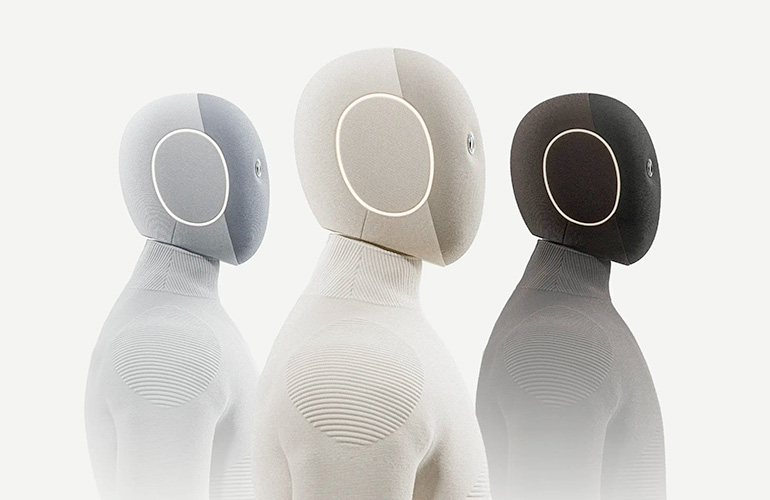
1X is accepting deposits for the delivery of the NEO Humanoid robot in 2026. | Credit: 1X
1X Technologies AS this week said consumers can pre-order NEO, the humanoid robot it has designed to be deployed in households. When the company unveiled its strategy to develop NEO in August 2024, it pivoted to focus solely on the in-home market for consumer humanoids.
The pre-launch announcement is noteworthy in that it signifies the beginning of a new phase in the race to deploy humanoid robotics into the consumer market.
The goal of NEO is to automate everyday chores and offer personalized assistance so people can spend more time on the things that matter, stated 1X. The company said it is giving NEO intuitive, user-friendly features and a core platform that is safe by design.
“Humanoids were long a thing of sci-fi … then they were a thing of research, but today — with the launch of NEO — humanoid robots become a product. Something that you and I can reach out and touch,” said Bernt Børnich, founder and CEO of 1X. “NEO closes the gap between our imaginations and the world we live in, to the point where we can actually ask a humanoid robot for help, and help is granted.”
In an interview with The Robot Report Podcast last year, Børnich described his vision for humanoids and his philosophy that while there remains a huge gap in the training data necessary for such robots, this problem is easier to solve in the home than in the warehouse or factory.
Børnich is not alone in this belief. Competitors Brett Adcock, founder and CEO of Figure, and Elon Musk, CEO of Tesla, have both claimed that the biggest opportunity for humanoids will be in the home. Adcock and Musk have also announced plans to commercialize and ship humanoid robots for household use by the end of 2026.
NEO understands verbal commands
In a recent video interview (24:39), Adcock predicted that the operational interface for humanoid robots will be speech, relying on large language models (LLMs) to properly interpret user intent. The robot will translate verbal requests into operational commands for the robot, he said. Multiple humanoid developers, including Figure, Tesla, 1X, and Agility Robotics, have already demonstrated this functionality.
Using its speech interface, called “Audio Intelligence,” NEO can recognize when it is being addressed, ensuring that it listens and responds only when appropriate, said 1X. Visual Intelligence adds contextual awareness — letting NEO use what it sees to enhance interactions, like recognizing ingredients on a kitchen counter and suggesting dishes to make.
Memory enables continuity across conversations, allowing NEO to recall past context and adapt its responses over time, according to 1X. From scheduling appointments and setting reminders for birthdays to keeping grocery lists and tracking progress in language lessons, not only would NEO save time, but it could also free up valuable mental space, the company asserted.
End users can train NEO for new tasks
Artificial intelligence will enable NEO to have conversations and navigate around the home to provide help where needed, 1X said. It noted that the robot will ship to early owners with the ability to handle basic tasks, and with continued use, it can learn and develop new skills.
NEO includes a feature called “Chores” that allows owners to give the robot a list of tasks and schedule a time for when they want them completed. 1X said the robot would be a personal housekeeper, tackling tasks like folding laundry, organizing shelves, and tidying spaces.
For any chore that NEO doesn’t yet know, owners could schedule a 1X teleoperator to guide it — helping the robot learn while getting the job done.
From Day 1, NEO will perform functions like opening doors for guests, fetching items, and turning off the lights at night. 1X said it will grow in abilities with every software update.
The company promised that privacy features are embedded in the robot, including “no go” zones in the home where the robot will never go, and the ability to blur the faces of people with whom it interacts.
1X designs for safety
Safety in a home setting is the primary hurdle to acceptance of this new technology. 1X said NEO’s hardware is built on its hardware experiences with prior models NEO Gamma and NEO Beta.
The latest platform is built with 1X’s patented Tendon Drive, which it claimed uses “the highest-torque density motors on earth” to drive its transmissions. This actuation system is designed to generate safe and compliant movements around people.

1X Tendon Drive actuation creates precise, low-energy movements necessary for home use. Credit: 1X
NEO includes a head-to-toe soft body made of custom 3D lattice polymer structures. At just 66 pounds (29.94 kg), NEO is capable of lifting 154 pounds (69.85 kg) and carrying 55 pounds (24.95kg). Additionally, NEO possesses built-in communication with WiFi, Bluetooth, and 5G as well as a three-stage speaker in the pelvis and chest area, giving owners a built-in mobile home entertainment system.
Pricing and Availability
NEO is now available for pre-order, with first orders shipping to consumer homes in 2026.
NEO will be available via 1X’s online store and comes in three distinct colors (Tan, Gray, Dark Brown). Customers interested in owning one of the first NEOs can purchase Early Access for $20,000, which includes priority delivery in 2026. There will also be a subscription model offering of $499/month.
1X will start delivering NEOs primarily in the U.S and expand to other markets starting in 2027.
The post 1X announces pre-order launch of NEO humanoid robot appeared first on The Robot Report.
